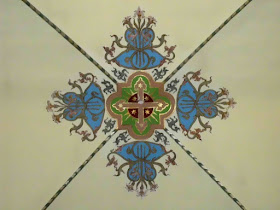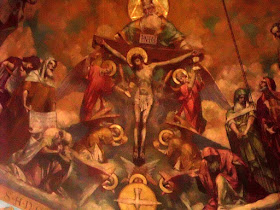Fr. Klenner was founding pastor and he immediately began planning a combination church/school, convent for Dominican Sisters and a rectory. The first church, a frame building, was built in 1906 and stood on the site of the current school building. Fr. Klenner led Holy Cross until he was replaced by Fr. E. Richert in 1921. Fr. Richert was soon transferred to Cleveland and was succeeded by Fr. Louis Kovacs.
 |
| Fr. Klenner |
 |
| Fr. Kovacs |
 |
| Henrik Kohner |
Henrik Kohner, born in Hungary and educated in the U.S., was architect of the current church and many other places of worship for Hungarian immigrants. The cornerstone was laid on November 24, 1924 and Holy Cross Church was dedicated on September 20, 1925.


Holy Cross Church was designed in a Gothic Revival style with many pointed arches. Twin, copper steeples have acquired patina over the course of 93 years.
Five enamel-painted windows in the sanctuary were created by Detroit Stained Glass Works and are original to the building. When I last visited Holy Cross, I spoke to an usher whose grandfather fabricated those windows. These sanctuary windows depict Christ flanked by Sts. Peter and Paul while the accompanying windows show Hungarian saints: Ladislaus, Elizabeth and Margaret.

The Holy Trinity is depicted in the apse above the high altar.
The transept windows were created in 1927, made of pot metal and painted enamel glass, and are the work of Ludwig von Gerichten. The west transept features depictions of the Holy Family, the Resurrection, and the Agony in the Garden.

The east transept features depictions of the Last Supper, Pentecost, and the Assumption of the Blessed Virgin Mary.

Most of the stained-glass windows are made in a Renaissance style. Pairs of windows on the lower-level show two saints who had close connections to each other. St. Francis de Sales and St. Jane Frances de Chantal are pictured together.

St. Augustine of Hippo is pictured alongside his mother, St. Monica.

Clerestory windows also show pairs of saints, from left: St. Mark the Evangelist and St. Matthew the Evangelist; St. Stephen the Protomartyr and St. John the Baptist.
Andres Dauber painted murals depicting the Mysteries of the Rosary in 1948.
A decorative, cruciform motif is painted in the center of the ceiling, where the transepts meet the nave.

Most of the marble was sculpted by Chicago's Pontifical Institute of Christian Art. In 2005, for the parish's centennial, a new ambo, presider's chair, and table altar were created to match to high altar.

Holy Cross has been under the direction of Franciscan Friars for decades so it's no surprise to see St. Francis of Assisi, St. Clare of Assisi and St. Anthony of Padua standing in corners of each transept. St. Elizabeth of Hungary also stands nearby.
Stations of the Cross were refurbished last year.



Side altars to the Blessed Virgin Mary and Sacred Heart of Jesus, respectively.
Our Lord and the evangelists on the facade of the pulpit.
Two angels, including one with a lyre, stand at the base of the pulpit. There are many Hungarian symbols throughout the church such as murals of angels holding shields with the patriarchal cross.


Small windows in the narthex show symbols of the seven sacraments.

Servant of God József Mindszenty, Primate of Hungary, Cardinal and Archbishop of Esztergom-Budapest, visited Holy Cross twice during his life time. Fr. Andrew Jacobs, a native of Delray, ministered at the parish as vicar and pastor.


A large plaque over the narthex commemorates parish organizations and deceased clergy.


The Baptism of the Lord is depicted on top of the baptismal font; hundreds of small crosses outline the many archways.


The Epiphany of Our Lord is depicted in the center window above the choir loft. A pelican and the Agnus Dei are also depicted on each side.

A Pieta stands in one corner at the back of the nave; Our Lady of Fatima in the opposite corner.
The Sacred Heart of Jesus and Our Lady Help of Christians stand by the main doorway.
A large crucifix and another Our Lady Help of Christians at one end of the narthex.
Holy Cross is one of few churches that still rings bells by pulling ropes. St. Joseph Oratory, also in Detroit, is the only other local church that I know of that still does this.
Saturday Vigil Mass is at 4:00pm in the church while Sunday Masses are at 9:00am (English) and 11:00am (Hungarian). On Fridays during Lent, Stations of the Cross are at 6:30pm in the church. Holy Cross is the only parish in the Archdiocese of Detroit to offer Mass in Hungarian.

The Garden of Gethsemane chapel is housed in the former school and hosts 9:00am Mass every weekday except Wednesday. Our Lady of Lourdes stands in a hallway of the former school. The statue may be reclaimed from the former Our Lady of Lourdes Parish, River Rouge, which was located two miles south.
The Detroit Mass Mob will visit Holy Cross Church on Sunday, April 15, for 11:00am Mass.

For more info: parish website
Previous blog posts: Te Deum + Detroit Church Blog
More history: Detroit's Historic Places of Worship + Discovering Stained Glass in Detroit + Detroit1701
More photos: Flickr + 75th anniversary book + 110th anniversary

























No comments:
Post a Comment